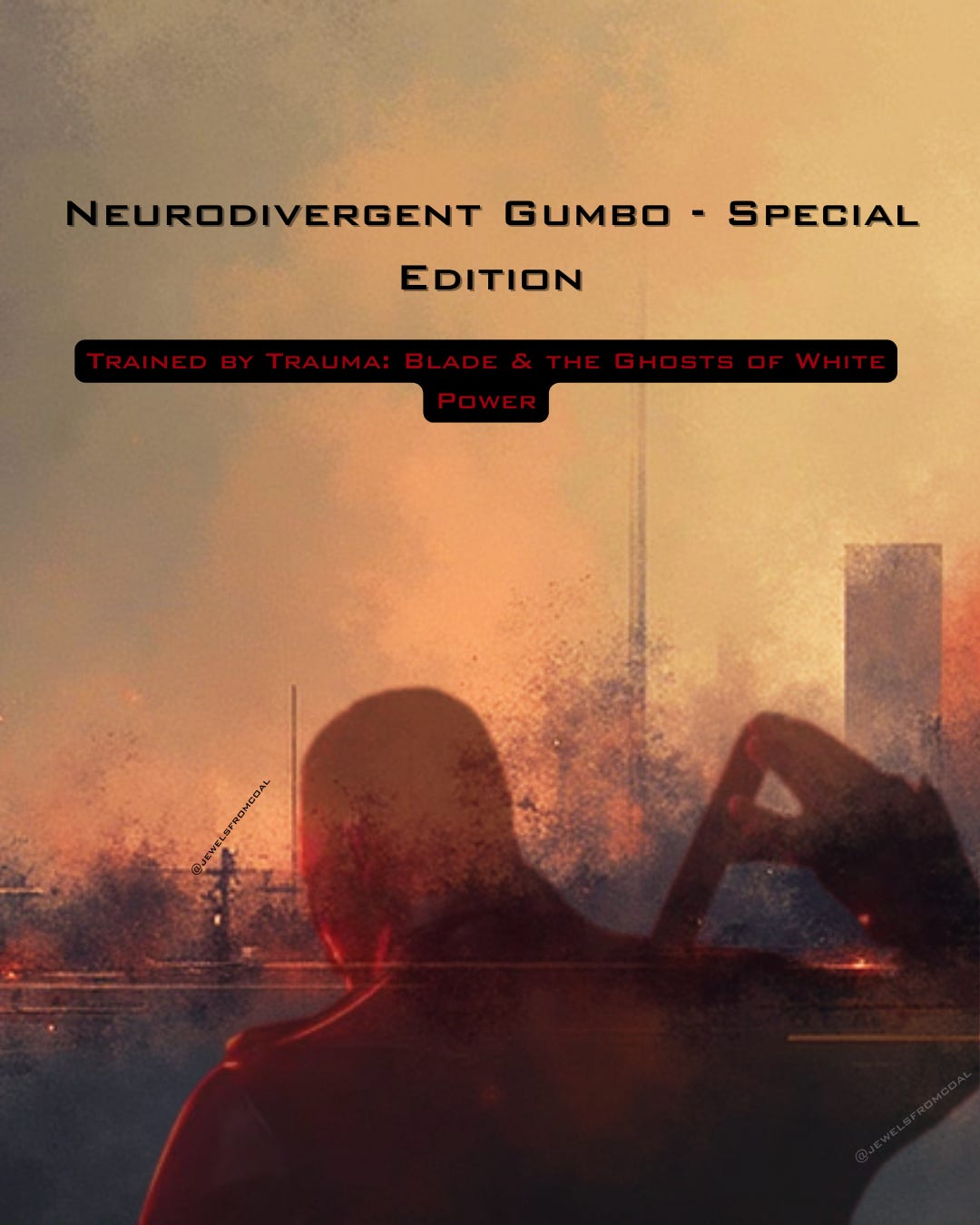Introduction: What the Bloodline Carries
Part of the Neurodivergent Gumbo series
In honor of Halloween, I’ve been watching vampire movies.
Not the glittery ones. Not the tortured white-boy ones.
I’m talking blood and blade. Fangs and folklore.
Blade is always a go-to for me—the action, the leather, the nostalgia.
It’s got that 90s grit, that pre-MCU edge, and Wesley Snipes giving us everything without apology.
But this time, I came to it with my Spicy Eye.
My Neurodivergent Eye.
My Third Eye with a side-eye.
And what I saw this time? Whew.
It cracked something open.
I’m taking a break from Disney right now. (Don’t worry—I’m still close by. Marvel is kin by merger.)
But I needed to step away from the princesses, from the happily-ever-after machine.
Because sometimes the horror genre tells the truth louder than fantasy ever could.
And sometimes the Black characters in those stories are asked to carry more than their weight.
Sometimes they’re asked to kill where they come from.
Blade is a film about isolation and weaponization.
A Black man trained by whiteness.
Made monstrous.
Told his strength comes from being what others fear.
Then I watched Sinners, and everything shifted.
This is a two-part reflection. First, Blade, then Sinners.
Then both of them—facing each other across the bloodline.
Because it matters who raises you.
It matters who teaches you to grieve.
And it matters what stories let you stay whole.
Trained by Trauma: Blade and the Ghosts of White Power
Blade was never just about vampires. Blade is a weapon trained by trauma—a Black body shaped by white pain, wielded against white terror.
In a cinematic era dominated by white saviors and sidekicks, Blade split the genre wide open. Wesley Snipes brought us something we hadn’t seen before: a Black protagonist forged by trauma, shaped by the enemy, and still unwilling to surrender his autonomy.
Whiteness as Parasite, Whiteness as Structure
Vampires in Blade are not just bloodsuckers. They’re an ecosystem of capitalism and colonization. They dress in tailored suits, own police departments, fund scientific research, and move through cities with centuries of entitlement. They are old money and new tech. Gothic and global.
They are whiteness in its most decadent form: insatiable, hierarchical, and self-replicating. But the system is also crumbling from the inside. The white characters around Frost—Quinn, Mercury, the cop familiar, and even the grotesque archivist Pearl—embody failures of strength, loyalty, or integrity. They are flippant, cowardly, indulgent, or absent when it counts. In contrast to Blade’s relentless discipline, their power is bloated, not earned. Their collapse foreshadows Frost’s own—hollow bravado wrapped in stolen elegance. Enter Blade. Not a hero. Not a villain. Something else entirely.
He walks between worlds, his body a battleground of infection and resistance. He was bitten in the womb—a half-breed, made by violence. Every day, he injects himself with serum just to stay human enough to fight. Every fight is a fight against himself.
He’s an addict, a warrior, a grim reaper with martial arts training and mirrored shades. And yet, he is never broken.
The Mentor is Not a Father
Blade is raised by Whistler, a gruff white man who arms him with silver bullets and deadpan cruelty. Their relationship mimics that of countless “protector/protege” narratives, but with one glaring difference: Whistler trains Blade like a tool. Not a son.
He calls him “the chosen one” in the context of LaMagra’s prophecy—not in reverence, but in warning. When he is injured and infected, he demands that Blade finish him off before he turns. “Don’t want me coming back.”
Even in death, Whistler maintains control.
Their final interaction is not tender. It’s a transaction.
Hardening Steel
Blade’s existence is pain, honed into precision. He doesn’t smile. He doesn’t flinch. He barely speaks.
But his silence isn’t emptiness. It’s calculation.
He is Black masculinity forged and tempered under pressure: made strong because the world will not make space for softness. He doesn’t have the luxury of banter. His quips are knives.
The body he wields is a site of resistance, not adornment. His coat is armor, not costume. His fighting is ritual. His blood is political.
Blade as Warning, Blade as Rebirth
In the final act, Blade drinks blood—human blood, gifted by Karen, a Black woman scientist and survivor. It’s not just sustenance. It’s reclamation.
He unleashes hell on the vampires, slaughtering them with righteous rage. Not because he enjoys it, but because someone has to hold the line.
And then he walks away. Not into glory. Into war.
The Power of Centering the Black Antihero
Blade is centered. Visually. Narratively. Spiritually.
He is not a token. He is not a punchline. He is the sun that the film orbits, even though the vampires can’t survive it.
In a decade that gave us Neo and Frodo, Blade stood alone—a Black antihero who didn’t explain himself, didn’t soften his edges, and didn’t ask for permission to exist.
He is not what the world wanted. He is what it deserved. 💎
Up Next: Blade and Sinners - The Reckoning
If Blade was prophecy, Sinners is the reckoning. Where Blade cuts through the myth of white salvation, Sinners asks what happens after the blood is spilled—when the ghosts remain and the ancestors speak back.
Part II draws the line—from weapon to witness.
From monster to man.
From the “half-breed” they named him to the whole being he becomes.
Stay tuned, love. We’re just getting started. - J


